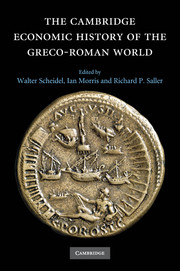Book contents
- Frontmatter
- 1 Introduction
- Part I Determinants of Economic Performance
- Part II Early Mediterranean Economies and the Near East
- Part III Classical Greece
- Part IV The Hellenistic States
- Part V Early Italy and the Roman Republic
- Part VI The Early Roman Empire
- 20 The Early Roman Empire: Production
- 21 The Early Roman Empire: Distribution
- 22 The Early Roman Empire: Consumption
- 23 The Early Roman Empire: The State and the Economy
- Part VII Regional Development in the Roman Empire
- Part VIII Epilogue
- Bibliography
- Index
- Map 1.1 The Mediterranean basin"
- Map 10.1 Greek and Phoenician trade in the period of the Persian Wars"
- Map 11.1 The Achaemenid empire"
- Map 12.1 Greece and Asia Minor"
- Map 15.1 The Seleucid empire"
- Map 16.1 Greco-Roman Egypt"
- Map 20.1 The Roman empire at the accession of Vespasian"
- References
20 - The Early Roman Empire: Production
from Part VI - The Early Roman Empire
Published online by Cambridge University Press: 28 March 2008
- Frontmatter
- 1 Introduction
- Part I Determinants of Economic Performance
- Part II Early Mediterranean Economies and the Near East
- Part III Classical Greece
- Part IV The Hellenistic States
- Part V Early Italy and the Roman Republic
- Part VI The Early Roman Empire
- 20 The Early Roman Empire: Production
- 21 The Early Roman Empire: Distribution
- 22 The Early Roman Empire: Consumption
- 23 The Early Roman Empire: The State and the Economy
- Part VII Regional Development in the Roman Empire
- Part VIII Epilogue
- Bibliography
- Index
- Map 1.1 The Mediterranean basin"
- Map 10.1 Greek and Phoenician trade in the period of the Persian Wars"
- Map 11.1 The Achaemenid empire"
- Map 12.1 Greece and Asia Minor"
- Map 15.1 The Seleucid empire"
- Map 16.1 Greco-Roman Egypt"
- Map 20.1 The Roman empire at the accession of Vespasian"
- References
Summary
introduction
The basic issues in evaluating the performance of the Roman economy in the early imperial period are to determine the extent of economic growth in aggregate and to assess the effects of economic change on various groups within Roman society, including wealthy aristocrats, urban residents, and peasant farmers. The growth of the city of Rome and of other cities in the Roman empire created a demand not only for agricultural products but also for manufactured goods, including luxury items. From the time of Augustus to the Antonine period, the population of the empire increased by about one-third, from some 45 to 55–65 million people, and much of this growth took place in the many cities of the empire. The populations of Rome’s largest cities exceeded those of the largest cities of Europe until the industrial revolution and were matched only in mediaeval China. Under Augustus, the city of Rome had, on most estimates, between 750,000 and one million inhabitants, while the early imperial period saw the rise of several provincial capitals with populations measured in the hundreds of thousands, including Alexandria, Antioch, and Carthage, as well as many more urban areas with much more modest populations. At the same time, the maintenance of relatively peaceful conditions in the Mediterranean world and the development of a more uniform legal system under Roman rule fostered commerce for these products by lowering transaction costs. The task of supplying the Roman empire’s urban population involved both the state and private producers in a complex network of exchange. Rome was fed with grain imported from Africa and Egypt.
Keywords
- Type
- Chapter
- Information
- The Cambridge Economic History of the Greco-Roman World , pp. 541 - 569Publisher: Cambridge University PressPrint publication year: 2007
References
- 34
- Cited by

